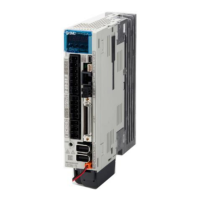Connecting a servo motor of the wrong axis to U, V, W, or CN2 of the driver may
cause a malfunction.
Before wiring, switch operation, etc., eliminate static electricity. Otherwise, it may
cause a malfunction.
Always connect a magnetic contactor between the power supply and the main
circuit power supply (L1/L2/L3) of the driver, in order to configure a circuit that
shuts down the power supply on the side of the driver’s power supply. If a
magnetic contactor is not connected, continuous flow of a large current may cause
a fire when the driver malfunctions.
Use ALM (Malfunction) to switch main circuit power supply off. Not doing so may
cause a fire when a regenerative transistor malfunctions or the like may overheat
the regenerative resistor.
Check the driver model, and then input proper voltage to the driver power supply.
If input voltage exceeds the upper limit of the specification, the driver will break
down.
The driver has a built-in surge absorber (varistor) to reduce exogenous noise and
to suppress lightning surge. Exogenous noise or lightning surge deteriorates the
varistor characteristics, and the varistor may be damaged. To prevent a fire, use a
molded-case circuit breaker or fuse for input power supply.
Connecting a servo motor of the wrong axis to U, V, W, or CN2 of the driver may
cause a malfunction.
The N- terminal is not a neutral point of the power supply. Incorrect wiring will
cause a burst, damage, etc.
EM2 has the same function as EM1 in the torque control mode.
Connect the 1-phase 200 V AC to 240 V AC power supply to L1 and L3. One of
the connecting destinations is different from LECSB□-S□ Series Driver's. When
using LECSB□-T□ as a replacement for LECSB□-S□, be careful not to connect
the power to L2.
Configure the wirings so that the main circuit power supply is shut off and SON (Servo-on) is turned off after
deceleration to a stop due to an alarm occurring, enabled servo forced stop, etc. A molded-case circuit
breaker (MCCB) must be used with the input cables of the main circuit power supply.

